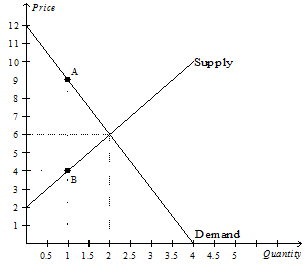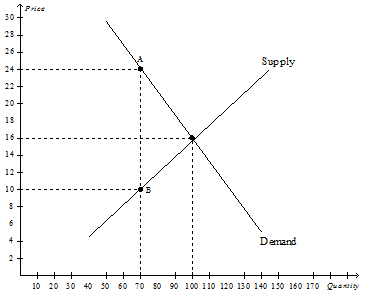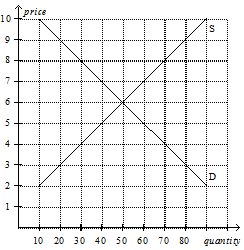True or False
1. The price elasticities of supply and demand affect both the size of the deadweight loss from a tax and the tax incidence.
2. Buyers of a product will bear the larger part of the tax burden, and sellers will bear a smaller part of the tax burden, when the supply of the product is more elastic than the demand for the product.
3. Suppose a tax of $1 per unit is imposed on a good. The more elastic the supply of the good, other things equal, the larger is the deadweight loss of the tax.
4. A price ceiling is a legal minimum on the price at which a good or service can be sold.
5. A price ceiling set below the equilibrium price causes quantity demanded to exceed quantity supplied.
|
Market
|
Characteristic
|
|
A
|
Demand is very inelastic.
|
|
B
|
Demand is very elastic.
|
|
C
|
Supply is very inelastic.
|
|
D
|
Supply is very elastic.
|
6. Suppose the government is considering levying a tax in one or more of the markets described in the table. Which of the markets will allow the government to minimize the deadweight loss(es) from the tax?
|
a.
|
market A only
|
|
b.
|
markets A and C only
|
|
c.
|
markets B and D only
|
|
d.
|
market C only
7. Suppose the government is considering levying a tax in one or more of the markets described in the table. Which of the markets will maximize the deadweight loss(es) from the tax?
|
a.
|
market B only
|
|
b.
|
markets A and C only
|
|
c.
|
markets B and D only
|
|
d.
|
market D only
|
|
|
|
|
8. The vertical distance between points A and B represents a tax in the market.

a) The imposition of the tax causes the quantity sold to increase or decrease by _____ units?
b) The imposition of the tax causes the price paid by buyers to increase or decrease by $_____
c) The imposition of the tax causes the price received by sellers to increase or decrease by $____
d) The amount of the tax on each unit of the good is $_________
e) The per-unit burden of the tax on buyers is $_________
f) The per-unit burden of the tax on sellers is $ _______
g) The amount of tax revenue received by the government is $ ________
h) The amount of deadweight loss as a result of the tax is $________
i) The loss of consumer surplus as a result of the tax is $_______
j) The loss of producer surplus as a result of the tax is $______
k) Consumer surplus without the tax is $ ______
l) Producer surplus without the tax is $______
m) Total surplus without the tax is $_______
9. The vertical distance between points A and B represents a tax in the market.

a) The equilibrium price before the tax is imposed is $______ and quantity is _______
b) The price that buyers effectively pay after the tax is imposed is $________
c) The price that sellers effectively receive after the tax is imposed is $_______
d) The per-unit burden of the tax on buyers is $________
e) The per-unit burden of the tax on sellers is $_______
f) The amount of tax revenue received by the government is equal to $__________
g) The amount of deadweight loss as a result of the tax is $__________
h) The tax results in a loss of consumer surplus that amounts to $_________
i) The tax results in a loss of producer surplus that amounts to $_________

10a. Refer to Figure above: Which of the following price controls would cause a shortage of 20 units of the good?
|
a.
|
a price ceiling of $4
|
|
b.
|
a price ceiling of $5
|
|
c.
|
a price floor of $7
|
|
d.
|
a price floor of $8
|
10b. Refer to Figure above: Which of the following price controls would cause a surplus of 20 units of the good?
|
a.
|
a price ceiling of $4
|
|
b.
|
a price ceiling of $5
|
|
c.
|
a price floor of $7
|
|
d.
|
a price floor of $8
|
10c. Refer to Figure above. Suppose a price ceiling of $5 is imposed on this market. As a result,
|
a.
|
the quantity of the good supplied decreases by 20 units.
|
|
b.
|
the demand curve shifts to the left so as to now pass through the point (quantity = 40, price = $5).
|
|
c.
|
buyers' total expenditure on the good decreases by $100.
|
|
d.
|
the price of the good continues to serve as the rationing mechanism.
|
10d. Refer to Figure above. Suppose a price floor of $7 is imposed on this market. As a result,
|
a.
|
buyers' total expenditure on the good decreases by $20.
|
|
b.
|
the supply curve shifts to the left so as to now pass through the point (quantity = 40, price = $7).
|
|
c.
|
the quantity of the good demanded decreases by 20 units.
|
|
d.
|
the price of the good continues to serve as the rationing mechanism.
|